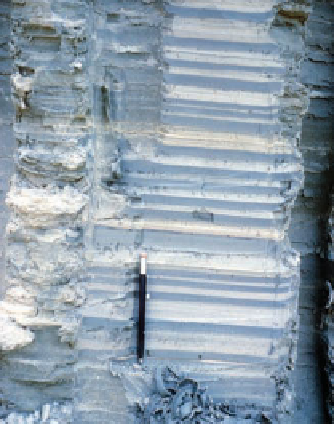Geology Reference
In-Depth Information
◗
Figure 14.20
Varves and a Dropstone in Glacial Deposits
Earth's orbit varies from nearly a circle (left) to an
ellipse (right) and back again in about 100,000 years.
a
Axis in approximately
41,000 years
Axis now
23.5
°
a
Each of these pairs of dark and light layers make up a varve, an
annual deposit in a glacial lake.
Earth moves around its orbit while rotating on its axis,
which is tilted to the plane of its orbit around the Sun at 23.5
degrees and points to the North Star. Earth's axis of rotation
slowly moves and traces out a cone in space.
b
Conditions now
January
July
At present, Earth is closest to the Sun in January (top),
when Northern Hemisphere experiences winter.
c
Conditions in about 11,000 years
July
January
b
These varves have a dropstone that was probably liberated from
fl oating ice.
In about 11,000 years, however, as a result of precession,
Earth will be closer to the Sun in July (bottom), when summer
occurs in the Northern Hemisphere.
d
◗
Figure 14.21
According to the Milankovitch Theory, Minor
Irregularities in Earth's Rotation and Orbit May Affect Climatic
Changes
Milankovitch attributed the onset of the Pleistocene Ice
Age to variations in three aspects of Earth's orbit. The fi rst is
orbital eccentricity
, which is the degree to which Earth's orbit
around the sun changes over time (
Figure 14.21a). When the
orbit is nearly circular, both the Northern and Southern Hemi-
spheres have similar contrasts between the seasons. However,
if the orbit is more elliptic, hot summers and cold winters
will occur in one hemisphere, while warm summers and cool
winters will take place in the other hemisphere. Calculations in-
dicate a roughly 100,000-year cycle between times of maximum
◗
eccentricity, which corresponds closely to the 20 warm-cold
climatic cycles that took place during the Pleistocene.
Milankovitch also pointed out that the angle between
Earth's axis and a line perpendicular to the plane of Earth's
orbit shifts about 1.5 degrees from its current value of
23.5 degrees during a 41,000-year cycle (Figure 14.21b).
















Search WWH ::

Custom Search